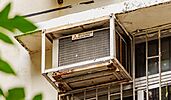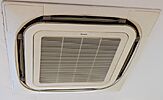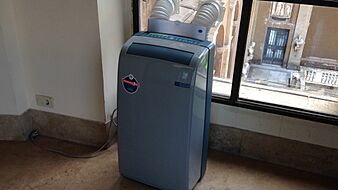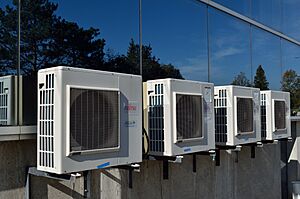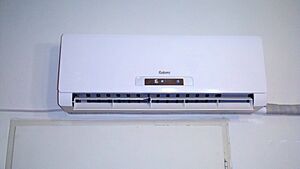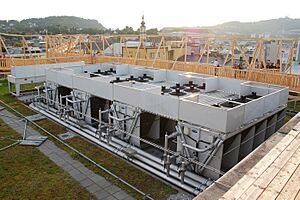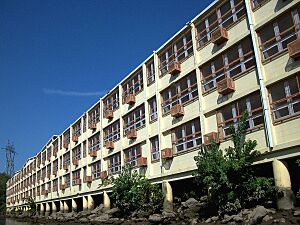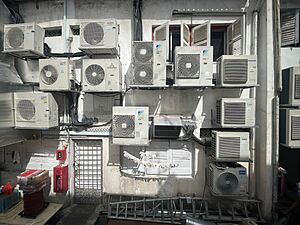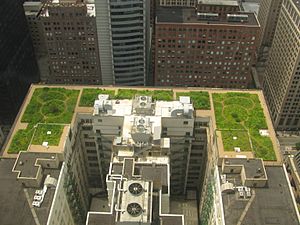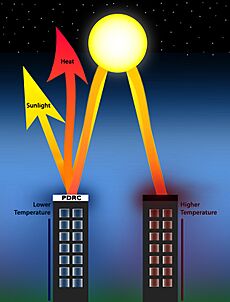Air conditioning facts for kids
Air conditioning, often called A/C or air con, is a way to remove heat from a closed space. This makes the inside temperature more comfortable. Sometimes, it also controls how much humidity (moisture) is in the air. Air conditioning can be done with a machine called an 'air conditioner'. It can also be done with other methods, like passive cooling (using natural ways to cool) or ventilative cooling (using air movement).
Air conditioning is part of a bigger group of systems called HVAC. Heat pumps are similar to air conditioners. They have a special part that lets them both heat and cool a space.
Air conditioners usually use a process called vapor-compression refrigeration. They come in many sizes. Some are small for cars or single rooms. Others are huge and can cool large buildings. Air source heat pumps are becoming more common. They can heat as well as cool, especially in colder places.
Air conditioners can help save lives when temperatures are very high. In 2016, about 1.6 billion air conditioning units were used worldwide. The United Nations has asked for air conditioning to be more sustainable. This means it should be better for the environment. They also suggest using other cooling methods. These include passive cooling, evaporative cooling, and better thermal insulation.
History of Cooling
People have tried to cool spaces for a very long time. This goes back to prehistory. In the ancient city of Hamoukar in modern Syria, buildings had double walls. Air could flow between the walls to help cool them. Ancient Egyptian buildings also used many natural cooling methods. These ideas spread across North Africa, the Middle East, and Northern India.
Natural cooling methods were common until the 1900s. Then, powered air conditioning became popular. Today, engineers are looking back at old building designs. They are using these ideas to create new, energy-saving buildings.
Air conditioners help buildings stay at a steady temperature inside. This happens even when the weather outside changes a lot. They also let people live comfortably in very hot parts of the world.
Early Discoveries in Cooling
First Steps Towards Modern AC
In 1558, Giambattista della Porta wrote about chilling ice. He mixed ice with potassium nitrate to make it much colder. In 1620, Cornelis Drebbel showed how to make a room cold for King James I of England. He used troughs and vats of water.
In 1758, Benjamin Franklin and John Hadley did experiments. They used evaporation to cool things fast. They found that evaporating liquids like alcohol or ether could make an object colder than water's freezing point. They even froze a thin layer of ice on a thermometer bulb.
The 1800s brought many new ideas for compression. In 1820, Michael Faraday found that compressing and then evaporating ammonia could cool air. In 1842, John Gorrie, a doctor in Florida, used a machine to make ice. He used this ice to cool the air for his patients. He dreamed of cooling whole cities. In 1851, James Harrison in Australia made the first mechanical ice-making machine.
First Air Conditioning Machines
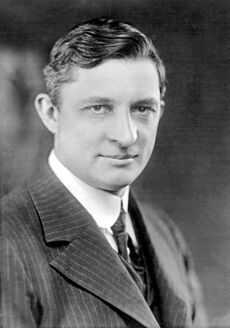
In 1901, an American inventor named Willis H. Carrier built what many call the first modern electric air conditioning unit. In 1902, he put his first system into a printing company in Brooklyn, New York. His invention controlled both temperature and humidity. This helped keep paper from changing size and ink from smudging. Later, Carrier started his own company, which became very successful.
In 1906, Stuart W. Cramer used the term "air conditioning." He was trying to add moisture to the air in his textile mill. He thought of it like "water conditioning" for fabrics. Willis Carrier liked the term and used it for his company.
Home air conditioning started to become popular. In 1914, the first home air conditioning was put in a house in Minneapolis. In 1931, H.H. Schultz and J.Q. Sherman created the window air conditioner. These units went on sale in 1932. A year later, air conditioning systems for cars were offered. Packard was the first car maker to offer AC in its cars in 1939.
More Developments in AC
In 1945, Robert Sherman invented a portable window air conditioner. It could cool, heat, add moisture, remove moisture, and filter the air. The first inverter air conditioners, which are more energy-efficient, came out in the early 1980s.
In 1954, Ned Cole created the first neighborhood with air conditioning in every house. This was in Austin, Texas. Researchers studied how AC affected the people living there. One funny discovery was that scorpions seemed to like the cool, shady houses!
Air conditioner use has grown a lot. By 2016, about 1.6 billion AC units were used worldwide. Most of these were in China and the United States. Experts predict that this number will grow to about 4 billion units by 2050. The biggest increases are expected in India and China. In 2015, about 87% of homes in the US had air conditioning.
Urban Heat Island Effect
The urban heat island effect means that cities are often warmer than the countryside around them. This was first noticed in London in the 1810s. From the late 1980s, studies began to connect air conditioners to this effect. When AC units release heat outside, they can make cities even warmer.
How Air Conditioners Work
Operating Principles
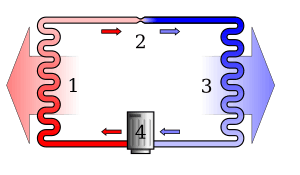
Most air conditioners cool air using a process called the vapor-compression cycle. This cycle uses a special liquid called a refrigerant. The refrigerant changes between a gas and a liquid to move heat. It takes heat from inside your home and releases it outside.
Air conditioners also reduce the absolute humidity (moisture) in the air. This happens if the cooling coil is colder than the air's dew point. A typical air conditioner will make the air in a room have about 30% to 60% relative humidity.
Many modern AC systems have a special dehumidifying mode. In this mode, the fan slows down. This makes the cooling coil colder, so more water condenses out of the air. A dehumidifier works similarly. It cools and dries the air, then warms it back up before releasing it.
Sometimes, if the air outside is cooler than the air inside, you can use "free cooling." This means the air conditioner doesn't need to use its compressor. This saves a lot of energy.
Heating with AC
Some air conditioning systems can also heat your home. They do this by reversing the cooling process. These are called "reverse cycle air conditioners" or air source heat pumps. A heat pump is much more energy-efficient than electric heaters. It moves heat from the outside air or ground into your home. When heating, the indoor coil gets hot, and the outdoor unit releases cold air.
Heat pumps can become less efficient when it's very cold outside (below 4 °C or 40 °F). This is because ice can form on the outdoor unit. To fix this, the system temporarily switches to cooling mode to melt the ice. Some heat pumps have extra electric heaters to keep the indoor air warm during this defrosting.
Newer models work better in cold weather. But ice can still form, so defrosting is sometimes needed. Because of this, heat pumps are sometimes used with other heating systems. For example, a gas furnace might be used on the coldest days.
Performance of AC Units
The coefficient of performance (COP) shows how well an AC system works. It's a ratio of how much cooling or heating it provides compared to the energy it uses. A higher COP means lower running costs.
In the U.S., AC power is often measured in "tons of refrigeration." One ton is like the cooling power of one short ton of ice melting in 24 hours. This equals 12,000 BTU per hour. Home central AC systems are usually 1 to 5 tons (3.5 to 18 kW).
The efficiency of air conditioners is often rated by the seasonal energy efficiency ratio (SEER). This rating helps you compare how energy-efficient different units are.
How well an AC works is also affected by how humid the air is. Removing moisture from the air before cooling it can greatly reduce energy costs.
Controlling Your AC
Wireless Remote Control
Many air conditioners use a wireless remote control. This remote sends commands using an infrared LED. The light from this LED is invisible to human eyes. This type of control is common for mini-split air conditioners because it's easy to use and carry. Some window and central AC units also use them.
Wired Controller
A wired controller, also called a "wired thermostat," is fixed to a wall. It controls the air conditioner by turning heating or cooling on or off. It uses different sensors to measure temperatures. Older mechanical thermostats use metal strips that bend with temperature changes. Newer electronic thermostats use special sensors to send electronic signals to the AC.
These controllers are often used in apartments, hospitals, offices, and hotels. They are wired directly into the AC unit, so they don't need batteries.
Types of Air Conditioners
| Types | Typical Capacity* | Air supply | Mounting | Typical application |
|---|---|---|---|---|
| Mini-split | small – large | Direct | Wall | Residential |
| Window | very small – small | Direct | Window | Residential |
| Portable | very small – small | Direct / Ducted | Floor | Residential, remote areas |
| Ducted (individual) | small – very large | Ducted | Ceiling | Residential, commercial |
| Ducted (central) | medium – very large | Ducted | Ceiling | Residential, commercial |
| Ceiling suspended | medium – large | Direct | Ceiling | Commercial |
| Cassette | medium – large | Direct / Ducted | Ceiling | Commercial |
| Floor standing | medium – large | Direct / Ducted | Floor | Commercial |
| Packaged | very large | Direct / Ducted | Floor | Commercial |
| Packaged RTU (Rooftop Unit) | very large | Ducted | Rooftop | Commercial |
* where the typical capacity is in kilowatt as follows:
- very small: <1.5 kW
- small: 1.5–3.5 kW
- medium: 4.2–7.1 kW
- large: 7.2–14 kW
- very large: >14 kW
Mini-Split and Multi-Split Systems
Ductless systems, often called mini-splits, cool and heat one or a few rooms. They don't use ducts and are separate for each area. Multi-zone systems are a type of ductless system. They can cool up to eight rooms independently from one outdoor unit.
The first mini-split system was sold in Japan in 1961 by Toshiba. Mitsubishi Electric sold the first wall-mounted mini-split in 1968. These were popular in Japan because homes were smaller. Multi-zone ductless systems were invented by Daikin in 1973.
Ducted Central Systems
Split-system central air conditioners have two main parts. One part is outside (the condenser), which releases heat. The other part is inside (the evaporator or Fan Coil Unit), which cools the air. Refrigerant flows between these two parts. The indoor unit then sends cool air through ducts to different rooms.
Central Plant Cooling
Very large buildings might use a central cooling plant. This plant cools water, which is then pumped to different parts of the building. This chilled water goes to units that then blow cold air into rooms. This is more efficient than sending cold air directly from a central plant. The water is cooled by machines called chillers. Chillers often release their heat using cooling towers.
Portable Units
A portable air conditioner is a unit on wheels. It has an indoor part and an outdoor part connected by flexible pipes. These are similar to mini-split units but can be moved.
Some portable units have hoses that vent hot air outside. Some collect water in a bucket, while others re-evaporate the water and send it out through the hose. Many portable units can also heat and dehumidify.
Window Unit and Packaged Terminal
Window air conditioners and packaged terminal air conditioners (PTACs) are similar. These units fit into a window frame or a hole in a wall. They have an inside part and an outside part. PTACs can also provide heat. They might use electric heaters or reverse the refrigerant flow to act as a heat pump.
Packaged Air Conditioner
Packaged air conditioners combine all the parts of a central AC system into one unit. They deliver air, sometimes through ducts, to the spaces that need cooling. These units can be placed outdoors or indoors, often on roofs. They can be cooled by air or water.
Types of Compressors
| Compressor types | Common applications | Typical capacity | Efficiency | Durability | Repairability |
|---|---|---|---|---|---|
| Reciprocating | Refrigerator, Walk-in freezer, portable air conditioners | small – large | very low (small capacity)
medium (large capacity) |
very low | medium |
| Rotary vane | Residential mini splits | small | low | low | easy |
| Scroll | Commercial and central systems, VRF | medium | medium | medium | easy |
| Rotary screw | Commercial chiller | medium – large | medium | medium | hard |
| Centrifugal | Commercial chiller | very large | medium | high | hard |
| Maglev Centrifugal | Commercial chiller | very large | high | very high | very hard |
Reciprocating Compressors
This type of compressor uses a piston that moves back and forth inside a cylinder. It's like the engine in a car. It has parts like a crankshaft and valves to compress the refrigerant gas.
Scroll Compressors
A scroll compressor uses two spiral shapes that fit together. One spiral stays still, and the other orbits around it. This motion traps and squeezes the refrigerant gas. They are more efficient than reciprocating compressors because they have fewer moving parts.
Screw Compressors
Screw compressors use two spinning spiral rotors that fit very closely together. As the screws turn, they pull in gas and push it through, making it smaller (compressing it). The gas then exits at the end of the screws.
Controlling Cooling Power
There are several ways to change how much cooling an AC system provides. Some common methods include turning the unit on and off, using a hot gas bypass, or using different types of compressors.
Variable-Speed Compressor
This system uses a special device called an inverter. The inverter controls the speed of the compressor motor. By changing the speed, the system can change how much refrigerant flows. This allows the AC to adjust its cooling power very precisely. This method is the most energy-efficient way to control an air conditioner's capacity. It can be much more efficient than systems that only turn on and off.
Impact of Air Conditioning
Health Effects

In hot weather, air conditioning can prevent serious health problems. These include heat stroke, dehydration from too much sweating, and kidney failure. Heat waves are a very dangerous type of weather. A 2020 study found that places with less AC use had more heat-related deaths and hospital visits. For example, a heatwave in France in 2003 caused about 15,000 deaths. Most of the victims were over 75 years old.
Air conditioning can also create clean, safe air in places like hospital operating rooms. It can help people with allergies, especially to mold. However, if water cooling towers are not cleaned properly, they can spread germs like Legionella pneumophila. This germ causes Legionnaires' disease. Keeping cooling towers clean with treatments like chlorine can prevent these health risks.
Economic Effects
Air conditioning first helped industries like printing and large factories. Studies showed that AC could increase worker productivity by almost 24%.
AC also changed where people lived. In the United States, the Sun Belt (warmer southern states) grew a lot after the 1970s. This was partly because AC made these areas more comfortable. Also, the number of summer deaths in hot areas of the US became more even across the country.
The widespread use of air conditioning greatly increases the demand for electricity. A 2018 report found that the energy used for cooling in the United States was more than the combined energy use of 4.4 billion people in Africa, Latin America, the Middle East, and Asia (not including China). By 2020, about 88% of US homes used AC.
Environmental Effects
Air conditioning used about 7% of the world's electricity in 2022. It also caused 3% of greenhouse gas emissions. A 2018 report predicted that electricity use for cooling would greatly increase by 2050. This would cause greenhouse gas emissions from cooling to almost double.
There is a big effort to make air conditioners more energy-efficient. The UNEP and the IEA found that if AC units were twice as efficient, 460 billion tons of greenhouse gases could be saved over 40 years. They also suggested laws to reduce the use of certain refrigerants. They also recommended better building insulation and more sustainable food supply chains.
Refrigerants (the liquids used in AC) have caused environmental problems. Older refrigerants like CFCs and HCFCs damaged the ozone layer. Newer refrigerants like R-410A and R-404A were designed to replace them. However, these can make climate change worse if they leak into the air. This happens because they have a high global warming potential (GWP). Newer HFO refrigerants are being used. They don't harm the ozone layer and have a much lower GWP.
Without international agreements like the Kigali Amendment, these refrigerants would have raised global temperatures even more.
Other ways to cool buildings include passive cooling, natural ventilation, and using trees for shade.
Some people talk about an "air conditioning paradox." This means that using air conditioners to deal with climate change (like hotter weather) actually uses more energy and creates more heat. This makes the problem worse. This is especially true in developing countries. While AC brings comfort, its widespread use could greatly increase carbon emissions.
The Cooling Problem
Cooling is very important today. A 2021 report estimated that about 345,000 people aged 65 and older died from heat in 2019. Air conditioning could have prevented these deaths. It's estimated that AC prevents about 190,000 heat-related deaths each year.
However, many air conditioning systems are not very efficient. This means heat waves can strain power grids and cause power outages. Power outages can be dangerous because people become more used to cool air. This makes them more vulnerable to heat-related illnesses without AC.
Also, the energy used by air conditioners often comes from non-renewable sources. AC units contribute about 4% of global greenhouse gas emissions. This is twice as much as the aviation industry.
The HFC coolants in AC units also add to climate change. If they escape into the air, they can trap much more heat than carbon dioxide. AC units are also hard to take apart and recycle. This means they are often thrown away, adding to pollution.
Solutions for Cooling
The goal is to meet the need for cooling without making climate change worse. Governments and researchers are looking for new solutions. More natural cooling methods are already being used.
Natural Cooling Solutions
Natural cooling methods don't need energy. This makes them very good solutions. Many ways to do this have been explored.
The way a building is designed can help it release heat. For example, a building in Zimbabwe used a design inspired by termite mounds. This cut its energy use by 90%.
Covering windows can reduce heat from sunlight. The U.S. Department of Energy says window awnings can lower heat gain from sunlight by up to 77%.
Painting roofs white has also been successful. In the United States, white roofs can lower roof temperatures by as much as 30 °C. In China, green roofs (roofs covered with plants) reduced cooling needs and lowered local temperatures.
Planting trees can also help reduce the heat island effect. Trees can lower city temperatures by as much as 12 °C in summer.
Renewable Energy for AC
As renewable energy becomes cheaper, more air conditioners are powered by it. This reduces the carbon emissions from making electricity.
Low-GWP Refrigerants
New refrigerants are being developed that have a low GWP. This means they trap much less heat if they escape into the atmosphere. This helps reduce their impact on climate change.
Social Effects
People with lower incomes often have less access to air conditioning. This makes them more at risk during heat waves. Studies show that areas with less AC use have higher rates of heat-related deaths and hospital visits. For example, in New York City, heat-related deaths are expected to grow. Lower-income groups are most at risk.
Differences in income and access to AC are sometimes linked to institutionalized racism. This can lead to certain communities having lower incomes, poorer health, living in hotter neighborhoods, and having less access to cooling. For example, a study found that Black households in some US cities were half as likely to have central AC as white households. In cities, Redlining (past unfair housing practices) created heat islands. These areas have more heat-absorbing materials and less green space. Some programs now provide public cooling spaces for low-income communities.
Other Cooling Techniques
Buildings designed with passive air conditioning are often cheaper to build and maintain. They also use less energy than buildings with regular HVAC systems. These methods can cool buildings by many degrees. However, they need to be designed carefully for each specific location.
Many techniques can make buildings more comfortable and cooler. These include evaporative cooling, selective shading, and using natural air movement.
Passive Ventilation
Passive Cooling
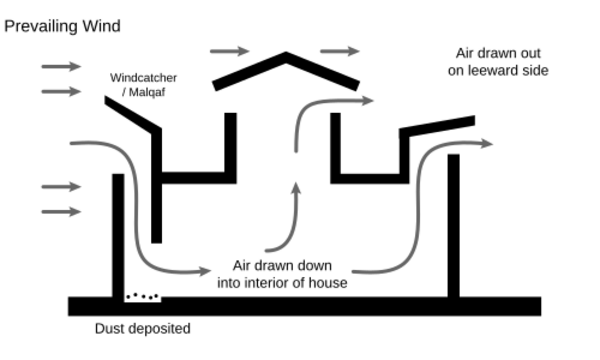
Daytime Radiative Cooling
Passive daytime radiative cooling (PDRC) surfaces are special materials. They reflect sunlight and send heat back into space. This helps them cool down during the day without using any energy. PDRC materials can be paints or films. They are designed to reflect a lot of sunlight and release a lot of heat.
Using PDRC on roofs can greatly reduce energy use and costs. In homes, PDRC roofs could cut energy costs by 26% to 46%. This technology is expected to grow a lot in the coming years.
Fans for Cooling
Hand fans have been used since ancient times. Large fans built into buildings, like the punkah, were powered by people.
In the 2nd century, the Chinese inventor Ding Huan created a rotary fan for air conditioning. It had seven wheels, each about 3 m (10 ft) wide. Prisoners powered it by hand. In 747, Emperor Xuanzong had a "Cool Hall" built. It had water-powered fan wheels and fountains for cooling.
Thermal Buffering
In places that get cold at night or in winter, people use heat storage. Heat can be stored in the earth or in stone walls. Air is then drawn past these materials to heat or cool it.
In areas where it freezes in winter, snow and ice can be collected. This ice is stored in ice houses to be used for cooling later. This method is over 3,700 years old in the Middle East. Wealthy Europeans also used to collect and store ice in the 1600s. Later, machines that make ice replaced this practice.
Evaporative Cooling
In dry, hot places, the evaporative cooling effect can be used. Water is placed where air enters a building. As air passes over the water, it cools down and becomes more humid. This can be helpful in a dry desert climate.
Evaporative coolers don't work as well when the air is very humid. This is because there isn't much dry air for them to work with. Unlike other AC types, evaporative coolers bring in outside air. This air passes through wet pads, which cool it. The cooled air then enters the house, pushing warmer air out through open doors or windows.
See also
 In Spanish: Acondicionamiento de aire para niños
In Spanish: Acondicionamiento de aire para niños
- Air filter
- Air purifier
- Cleanroom
- Crankcase heater
- Energy recovery ventilation
- Indoor air quality
- Particulates


